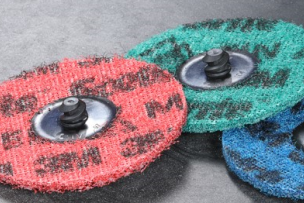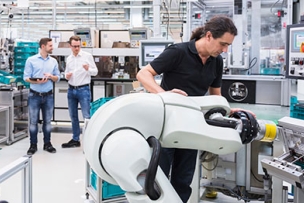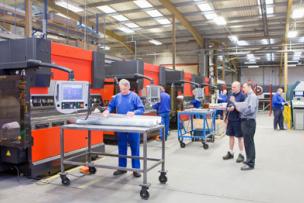Carrying more power to more people with lighter power lines. Keeping manufacturers on the cutting edge of competitiveness with abrasive solutions and surface modifying systems. Helping manufacturers make more with less through leaner processes. Automating health care data so the right people get the right information to take action. These are some of the ways we’re working to support stronger communities and sustainable development across the globe. We see the world's challenges clearly and unite the people that dare to solve them. We innovate with purpose and use science every day to create real impact in every life around the world.
In recent years, the abrasive industry has seen significant advancement in technology.
The incorporation of new tools and innovations like Precision Shaped Grain (3M) into abrasive operations can increase efficiency and productivity. All abrasives are engineered to perform with an optimal breakdown point. That is, the abrasive grit must break down to reveal new cutting edges. However, this point is often not reached, and maximum output potential is reduced because the abrasive is applied with unsuitable pressure. If you have a product that should be lasting twice as long, but you’re only seeing average output, then other mitigating factors need to be addressed. One such facet of abrasive grinding that is often overlooked or misunderstood is pressure. The two key components to ensure optimal abrasive performance include selecting the correct product and running that product at the appropriate pressure. The key is matching the product to the application’s pressure. Under appropriate pressure conditions, you can ensure an optimal breakdown rate of your abrasive belts, maximizing both cutting speed and product life.
3M PRECISION SHAPED GRAIN

In the last several years, 3M scientists have fine-tuned innovative precision grain technology. First introduced to the industry in 2009, 3M Precision Shaped Grain (PSG) is an abrasive grain that performs at a higher capacity than traditional crushed grain. Crushed grain is manufactured by conventional crushing and screening techniques producing a varied distribution of particles in both size and sharpness. When the crushed grain is coated onto an abrasive backing, the result is a distribution of irregular shapes and heights of grain. Conversely, using PSG yields a desirable and virtually monolithic distribution of abrasive grains that are readily available to perform abrasive manipulations on work surfaces as shown in Figure 1.
The mechanism for metal grinding and chip formation is one of the key factors in fundamentally understanding why PSG products perform at such a high level.

Conventional crushed ceramic grains—because of variations in grain distribution and mineral sharpness—have cutting tips that act as “plows” as they cut, which cause high frictional force and heat build-up in the substrate. The homogenous shape and sharpness of the PSG slices through metal, resulting in more efficient chip formation and metal removal while greatly reducing heat-related part damage. Figure 2 illustrates the plowing of the crushed grain versus the cutting of precision shaped grain. As with all abrasives, PSG-containing belts perform at peak capacity when operated under suitable pressure.
UNDERSTANDING BELT AND APPLICATION PRESSURE
Combining the right belt with the right application pressure is essential to reaching the optimal breakdown point of an abrasive. The wrong variable in either of these fields can lead to suboptimal results evident on the workpiece and the used belt. Using either excessive pressure or insufficient pressure during grinding can have effects on the performance of an abrasive and the materials it’s grinding.
Understanding how low and high pressure abrasives operate can be visualized like a bed of nails. If a person were to lay their hand across compact, closely spaced nails, it would require lots of force and pushing against the nails to puncture the skin. Imagine now a single nail stuck through a board: significantly less force would be required for the nail to penetrate if someone pushed their palm against it. Similar to a bed of nails, high pressure belt surfaces have many grains tightly packed together and can withstand higher force during application.
Low pressure belts are designed with grains placed further apart so less force is needed for them to cut through the substrate. This is the concept of application pressure: the force applied divided by the geometry of the workpiece. High application pressure requires closely spaced minerals, and low application pressure requires minerals that are further spaced out. Selecting the appropriate belt pressure—high, medium or low— for the desired surface modification is the first component for yielding optimal abrasive performance.

In some cases too much pressure can be applied to an abrasive. This is more likely to occur in an automated system, although it can occur in an off-hand application as well. Typically, it is more likely to occur in automated or robotic grinding systems where application pressure is high to achieve high removal rates. A telltale sign to look for in this instance would be shelling. Figure 3 depicts an example of a belt where too much pressure was applied and shelling occurred. The shelling can be noticed first at the splice. If shelling occurs before optimal abrasive life is reached, it is likely that application pressure is too high. In these cases, selecting a product with a higher application pressure range would be appropriate. An abrasive like 3M™ Cubitron™ II 984F Abrasive Belt performs well under these very high pressure conditions and diminishes the likelihood of shelling.

In most cases, the application pressure is too low for the product selected. Applying too low of pressure results in different visual cues. The telltale sign of insufficient pressure is when glazing, or capping, occurs on the abrasive. Figure 4 shows an example of an abrasive belt where glazing occurred. In the side-by-side comparison, it is evident the belt on the right appears capped with metal from the workpiece. This happens because pressure that is too low causes the abrasive to rub, rather than cut, the substrate. The friction incurred from the rubbing increases the heat between the belt and the workpiece. This can result in pieces of the workpiece being welded to the abrasive. Glazing, or capping, can occur after one application if the pressure is insufficient and will effectively curtail the lifespan of the abrasive. The appearance of shelling or glazing on used abrasive belts are visual cues that the belt selection, application pressure, or both should be altered.
To continue reading this white paper in its entirety and learn about recommended testing procedures, download a PDF here.
Previously Featured on 3M's site.







Talk to Us!
Leave a reply
Your email address will not be published. Required fields are marked *